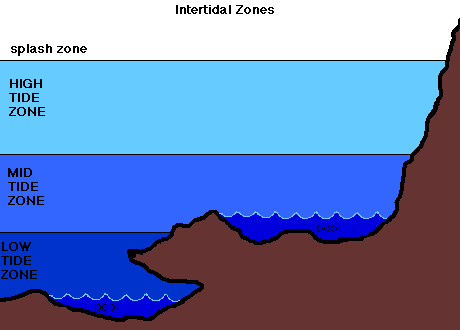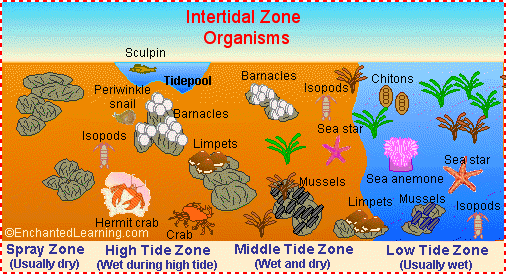Tides and Tidal Zones
Tides
- The rising and falling of the sea
- Produced by the gravitational pull of the moon and the sun
- There are two high tides and two low tides per day
- Water at its highest level
- The water on the same side of the moon bulges out toward the moon
- The ocean also bulges out on the opposite side of the Earth.
- Water is at its lowest level
- Moon forms a right angle with location on Earth
- The ocean is also at low tide on the opposite side of the Earth
- When the high tide and low tide have the greatest difference
- Happens during new moon and full moon
- Has NOTHING to do with Spring; called this because the tide is "springing forth"
- When high tide and low tide have the least difference
- Moderate tides
- Happens during the first and third quarter moon, seven days after spring tide
Intertidal Zones
- The shoreline is broken down into 4 tidal ‘zones’ based on beach location and how often they are covered by water.
- Upper intertidal
- Location of extreme high tide waters
- Positive tide
- Location of normal high tide waters
- Positive tide
- Location of normal low tide waters
- Negative tide
- Not an intertidal zone, but…
- Location of extreme low tide waters
- Negative tide

Adaptation
- A characteristic that helps a living thing survive and function better in its environment.
- Organisms that live in the intertidal zone have different adaptations that allow them to survive.
Unique conditions of intertidal zones
Sometimes area is dry
- Must be able to tolerate exposure to air
- Organisms must have a way to prevent drying out
- Example: Shells of oysters or snails
Intense wave action
- Organisms must be able to tolerate splashing
- Necessary adaptations
- Thick shells (Turban snails)
- Ability to attach to rocks (Barnacles and Anamones)
- Barnacles open and close to hold in water to keep from drying out
- Anemones survive wave action by attaching themselves to the side of large rocks
- Area high on beach
- Dry most of the time
- Only wet when wave splashes
- Species adaptation:
- Must be able to prevent drying out. Many have protective shell
- Example organisms: Lichen, isopod, periwinkle snails, amphipods
- Only covered by water at high tide
- Intense wave action
- Special species adaptation:
- Thicker shells, attach to rocks
- Example Species: Anemones, barnacles, turban snails
- Most active region
- Covered and uncovered by water twice a day
- Special Adaptation:
- Must be able to tolerate submersion in water AND exposure to air
- Example species: seaweed, crabs, sea stars, mussels
- Low Intertidal Zone (and Subtidal Zone)
- Usually submerged
- Most food and shelter
- High diversity of organisms
- Animals are NOT adapted to exposure to air.
- Special adaptation:
- Creatures are mobile
- Example organisms: Predators: fish, octopus, and jellyfish
- Threats to Intertidal Zones
- Limited time to feed
- Changing temperatures
- Changing salinities
- People


